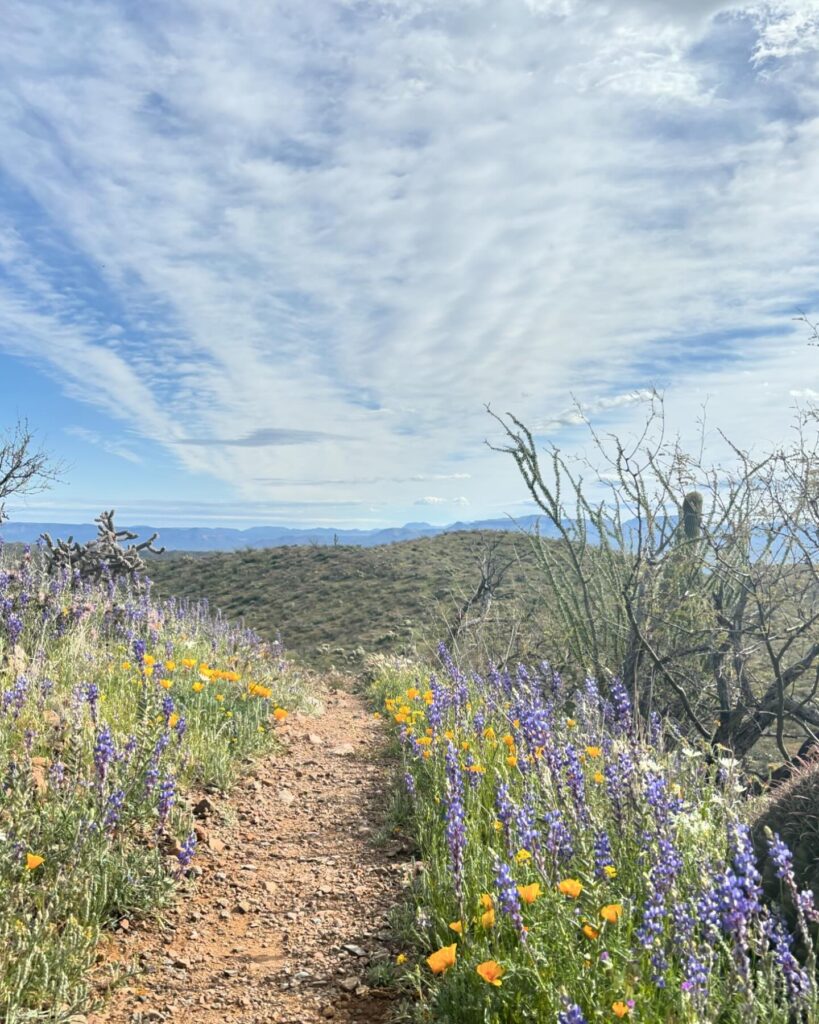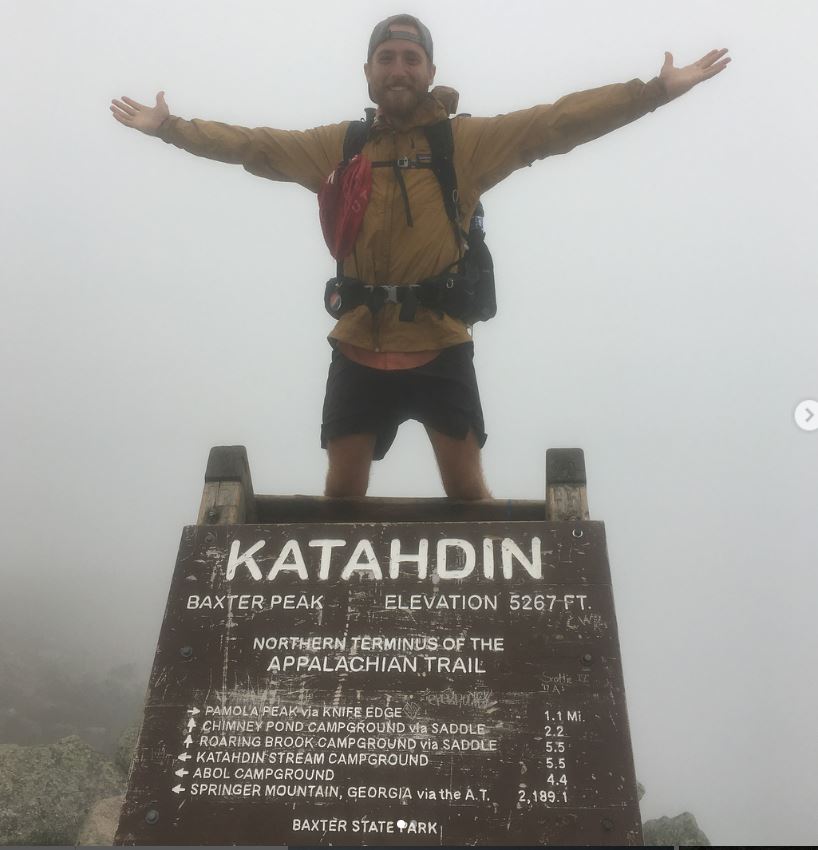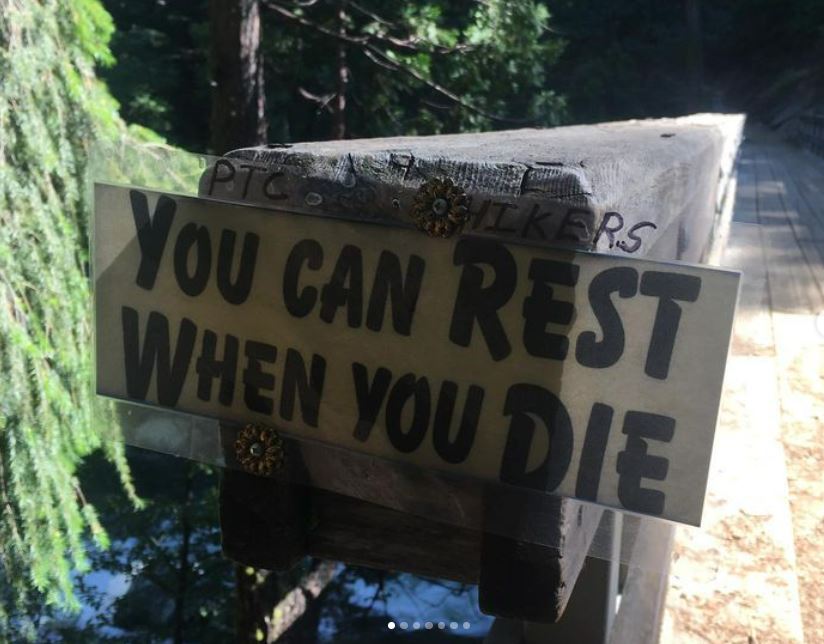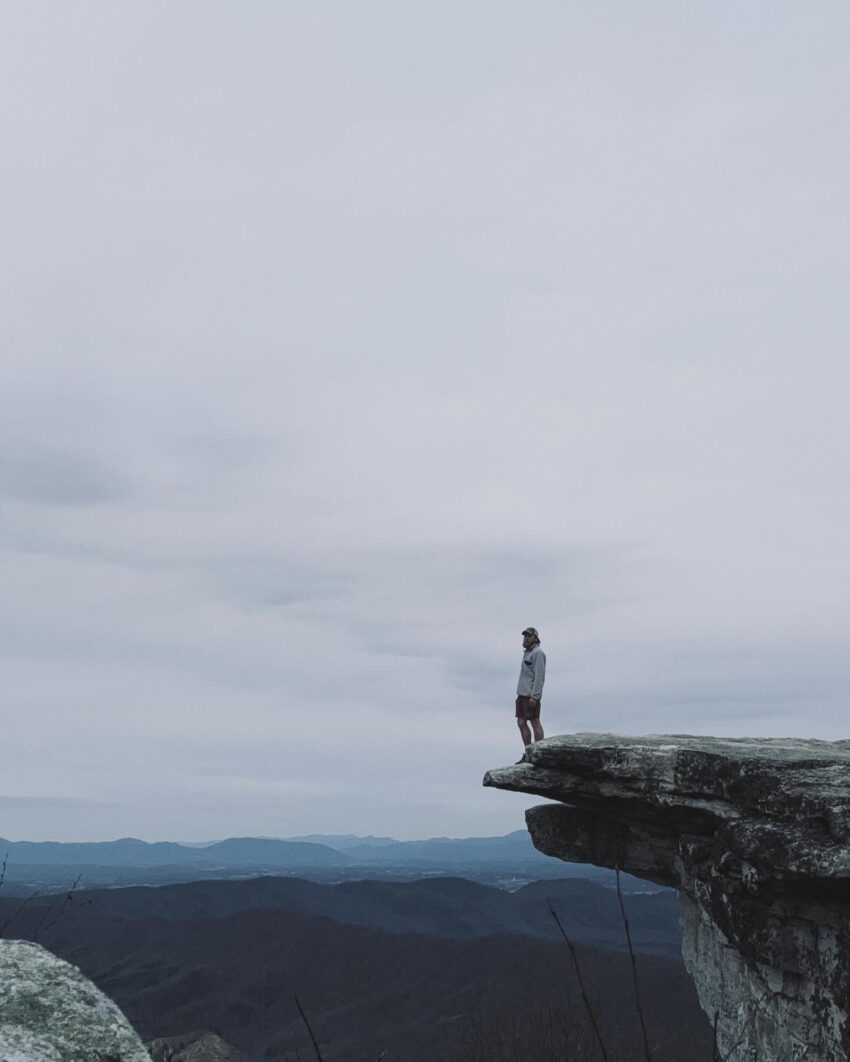Today we share the amazing story of Alex Hoffman (Trail Name -Lost Boy) who is hiking the Triple Crown in a calendar year. What makes Alex’s story even more amazing is that is he achieves this goal he will be the first person with Type 1 diabetes to achieve this goal. As a physician caring for many patients with this condition it gives me special appreciation of the additional challenges Alex faces every day.
The Triple Crown is the Appalachian Trail (2,194 miles) , Pacific Crest Trail (2,653 miles), and Continental Divide Trail (3,028 miles).
https://en.wikipedia.org/wiki/Triple_Crown_of_Hiking
We met Alex on a rest day in Harpers Ferry West Virginia at our friends lodge The Towns Inn. I noticed Alex’s well loved pair Altra Lone Peak and we struck up a conversation.
Alex has covered this much trail so far in 2024 and as the weather gets springier this is the plan:
“I’ve hiked from Georgia to Connecticut so far on the AT. Once I finish the AZT (Arizona Trail), I’ll jump over to the PCT and hike northbound from Mexico to Canada, then hop over and finish the last 600 miles of the AT and finally head back to Montana and hike the CDT southbound from Canada to Mexico…. Phew it’s exhausting just typing that”
When not on the trail, Alex calls Grand Rapids Michigan home . He worked as a carpenter prior to this adventure ….a useful job skill I’m sure for a year in the woods.
You can follow Alex on Instagram @lostboyat
Now to the story!

What inspired you to hike the Triple Crown? What is your why for this big hairy goal?
I’ve always been someone who feels most alive when I’m pushing myself and seeing really how much I can take and how far I can go. I feel when we stretch the boundaries of our comfort zone, we find we’re capable of so much more than we ever imagined. The inspiration for the Calendar Triple was sort of born from covid originally. I was dealing with post trail depression after finishing the PCT in 2019, I had moved to a new state for work where I knew almost no one, so there was the uncertainty of a new unfamiliar place and suddenly the whole world went into lockdown. That was a really lonely time. I was watching a lot of YouTube videos of other hikers adventures and came across a video of the calendar triple crown. I thought, if he can do that, so can I.
So I started planning, but I didn’t necessarily imagine it would ever happen. It was more of just a way to cope and pass the time. I was making spreadsheets, researching resupply options and basically living virtually on trail since I couldn’t be there physically. Then 2023 threw me a few curveballs, the most notable being my type one diabetes diagnosis at the age of 28. I knew something was wrong for a while but up until then I had always believed I was invincible.
I was pretty deep in denial even after looking up my symptoms and all the signs pointing straight to it. I was so tired all the time. I couldn’t keep my eyes open at work. I had such low energy it was legitimately hard to even move. Every muscle in my body ached. My mouth was dry no matter how much I drank, not to mention I was urinating 30 plus times a day and waking up every hour to do so throughout the night. My eyesight was rapidly declining. I was eating constantly but dropping weight like crazy. Despite all of that going on for months, I wouldn’t go to the doctor until one morning I couldn’t feel my left leg from the knee down. It was like when you’re sitting in a strange position for too long and your leg falls asleep but nothing I did would wake it up.
I could barely stand on the scale in triage without falling over. I weighed 119 pounds. Six months ago, I was 160. My blood sugar was 547, ketones were off the charts, their A1C test only went up to 14% and mine just said >14. I remember lying in the hospital bed hooked up to all kinds of wires, going through countless saline IVs and doctor after doctor coming in to tell me a lot of information I wouldn’t remember or understand. As the endocrinologist was leaving, he asked, “Do you have any questions?”. I had very limited knowledge of what diabetes was, so I asked “This is reversible though right?” . And he looked at me with what I believe was genuine compassion and said “I’m sorry, no. You’ll need to take insulin for the rest of your life.”
Just a few months ago I was running 7 minute/mile splits, lifting weights, rock climbing in the Red River Gorge, and now seemingly overnight, I can barely walk, I’m wearing +3 readers I picked up at Walmart just so I can see. And all of a sudden I’m taking all these pills and giving myself multiple shots every day and waking up with panic attacks every night. I thought my hiking career was over. I thought my life was over.
For the first time in my life I felt weak, vulnerable, and afraid. I felt my mortality and through all of this, I was alone. After a few weeks of feeling sorry for myself and wondering why this happened to me, I remembered my friend Rampaige who I met on my thruhike of the AT in 2018. Rampaige -a triple crowner, an all around bad ass and, yes, a type one diabetic. So I reached out.
I said it’s hard enough to hike these long trails, and this disease feels impossible, how on earth did you do it? She gave me a lot of very good advice, tips and tricks and offered very kind words, only someone who’s lived with this could understand. And when I told her about my dream to hike all three triple crown trails in one year, she said exactly the right thing that would ensure I would at least attempt it. “You would be the first type one to do it.”
That’s all it took and immediately my mindset changed. This is another obstacle but it isn’t the end. This didn’t happen to me, it happened for me. I have the opportunity to do something no type one has done before and show everyone living with this disease that it doesn’t have to hold them back from accomplishing any dream they can imagine. My “why” began as just that I wanted to, but now I needed to; to prove to myself that I wasn’t going to roll over and let diabetes ruin my life. I was going to stand up, take control, and fight back.
Where are you now on the trail?
As I write this, I am in Pine, Arizona. Just over halfway done with the Arizona Trail (AZT), and around 1,900 miles hiked this year. I was feeling a little down and burnt out after my Katahdin summit attempt, but it’s still too early for the other two trails, so I came out to the AZT for the sunshine and social experience to kind of reset and palate cleanse before starting the PCT.
How did you prepare physically and mentally for such a long journey?
For a few months prior to starting this hike, I was living a short drive from Manistee National Forest so on the weekends I would go out and hike 50-60 mile sections of the North Country Trail between Friday and Sunday nights, then back to work on Monday. That’s a really beautiful trail that I hope to thruhike some day!
You have Type 1 Diabetes which makes this another level of challenge. What is your food and insulin strategy that makes you different from the fueling of other hikers?
Note my clarification in parenthesis for non-medical folks
I have to be a lot more careful. While the average thruhiker can survive off ramen bombs, pop tarts and honey buns on trail and absolutely gorging themselves into food comas in towns, it takes a significant amount of consideration on my part if I want to achieve the same level of satiation. That means more insulin, but with that comes more risk of lows, especially with how much I’m exerting myself on a daily basis. There have been a few times I’ve woken up low in the middle of the night and had to crawl to take down my bear bag which is hung up in a tree 50 yards away. Like every type one, it’s something we have to think about 24/7.
What’s my number (blood glucose)? Which way is it headed? When and how much was my last dose (insulin) ? How much is this (blood glucose) climb going to effect my ratio (carb to insulin) for the rest of the day? I really want to eat this entire pizza but I’m worried I’ll go high (glucose) and have to bolus (additional insulin) more than I planned for when I don’t have a resupply for another week. Now I’ll have to ration for a few days and decide between going high or hungry. These are all thoughts I have on a daily basis. It’s tough, and I’ve certainly made my share of mistakes in learning how to navigate diabetes in the context of thruhiking, but it is doable. It just takes a little extra planning, and giving yourself a lot of grace.
Can you share a particularly memorable experience or encounter you’ve had along the trail?
Oh there are so many. Post-holing through the smokies in January was a pretty wild experience. It was so beautiful and serene and quiet up there, and then there’s me exerting every last bit of effort I’ve got, breaking trail up to my waist for hours and hours and barely making any progress. At the time it was so difficult and draining and really really cold ; but the views, when I got them, were so rewarding. I remember getting into a shelter one night after hiking all day and only making 10 miles and stripping off my soaking wet clothes because it had been raining all day as well, and crawling into my quilt and just immediately falling asleep into that deep rest you feel like you’ve really earned. I will always look back on that time and feel strong and proud that I persevered and accomplished something I wasn’t sure I was capable of.
How do you navigate the logistics of food and shelter while on the trail? What do you look most forward to on a resupply day?
I typically plan my next resupply the night before I go into town, and the same with campsites/shelters. I use the app Farout to look ahead at the elevation profile, water sources, and what campsites or shelters are around the kind of mileage I expect to make and shoot for that the following day. I don’t always make it, and sometime I realize I can go further, but I’ve pretty well dialed in how many days each segment will be based on averages so that there is a little wiggle room on individual hiking days.
My last night out before a resupply I’m looking at the mileage to the next town and how many days that breaks down into so I know how much food I’ll need to carry. I’ll look for lodging if I plan to stay in town, if there is a grocery store in walking distance, and what restaurants are around. I’m pretty efficient once I’m in town. Shower, laundry, town meal, resupply, call mom so she knows I’m alive, upload all the content from the previous stretch and go to sleep.
On resupply day, I most look forward to town food! Mexican is my go to. It’s always good.
How do you stay motivated during the tougher stretches of the trail?
I think a lot about the fact that it is incredibly unlikely I will ever have this opportunity again, and there’s no promise of tomorrow. Life is short and I want to take in as much beauty and knowledge and joy and see and do everything I possibly can while I have the privilege of living on this earth. I am immensely fortunate to have the ability right now to spend one entire year pursuing this dream. But I’m almost 30 years old and there are other things I’d like to do too. So it really feels like it’s now or never. And there are so many people supporting me and rooting for me. I don’t want to let them down.
What wildlife have you encountered along the way?
The AT unfortunately was almost exclusively shelter mice, as I was there in the dead of winter, although there was one particularly fun grouse that followed me down the trail for about a quarter mile in Shenandoah. Here in Arizona, I’ve seen deer, rattlesnakes, javalina, elk, a whole lot of cows, lizards, quail, you name it.

How do you handle the social aspect of the trail, meeting other hikers and potentially forming trail families?
I love meeting other hikers! The people are such a huge part of what makes these adventures so special. I tend to move fast and stick to my own schedule, so when I do join up with a group, it doesn’t typically last very long, but then I get to move up the trail, meet a whole new group of people and hike with them for a while, so it really feels like the best of both worlds without compromising my hike!
What advice would you give to someone considering hiking the Appalachian Trail or Triple Crown?
I say just go for it. Research gear and do a couple shake down hikes to ensure you know how to use it, but really you’ll figure out the rest when you get there.
Say yes. Be open to the experience and allowing the adventure to unfold. Don’t get too caught up in your expectations of what you think it should look like or what you think you should be doing. Remember it’s about the journey, not the destination. Smiles over miles. You’ll get there when you get there.
How do you deal with the physical demands of the hike, such as blisters, fatigue, and muscle soreness?
I am very lucky that I don’t get blisters. I did when I first started backpacking but I’ve dialed in my kit, found a shoe/sock combo that works really well for me, and haven’t had an issue since.
As far as fatigue and soreness, I’ve gotten really accustomed to listening to my body. When I’m tired, I rest. When I’m sore, I stretch. Sure, this level of exertion is going to put strain on the body, there’s no way around that. You’re always going to be in a little bit of pain but it’s crucial to recognize that it’s ok to slow down sometimes and that maybe calling it a day a little early even when you don’t make the miles you set out to is ultimately beneficial if it means avoiding injury and staying on trail.
What’s your favorite part of the trail so far, and why?
My favorite part of the AT so far was either the Roan Highlands or eating at every deli in NJ/NY. Both experiences were absolutely sublime for very different reasons.
That said, I’m kind obsessed with Arizona. This state is so beautiful and the desert will always be my favorite biome.
How do you balance solitude and companionship during such a long hike?
To be successful at a hike of this caliber, you need to be really comfortable being alone. I feel pretty lucky to be able to go days without talking to anyone and not lose my mind. It’s either that or it was already gone to start with. Of course, we’re social creatures so when I do have the opportunity to converse and share a moment with another hiker or someone in town, I take full advantage and probably appreciate it a lot more than the average person. And if I need a break from my own thoughts, I have a bunch of podcasts and music downloaded and can just pop a headphone in (I leave one out for rattlesnakes and bears).
What gear has been indispensable for you on the trail?
The practical answer would most likely be my water filter, without which I would probably be sick pretty often, but my favorite piece of gear is my quilt. I use the 20° enlightened equipment revelation and I am comfy and cozy wrapped up in that thing every night. When you carry so little, it’s important to have something that feels like home, and for me it’s just that.
What is your fav shoe and why?
I wear the Altra Lone Peaks. Zero drop feels like a more natural way to walk and you really can’t beat the wide toe box. I’m lucky to have found a shoe that works well for me early on and figure I’d m if it’s bit broke don’t fix it.

How do you handle the varying weather conditions along the trail?
On a shorter hike, I might have said “if there’s bad weather, I can wait it out in town” but the pace required on this trip doesn’t allow much room for that. You have to hike every day, come what may. So, for lack of a better phrase, I embrace the suck. I laugh at how ridiculous some of the situations I put myself in can be. I remember that this too shall pass. I may be a little uncomfortable, (cold, wet, what have you) for a while, but it will get better. And the most important lesson I’ve learned from hiking the AT or any trail is that the most growth and confidence and inner strength comes from putting ourselves in uncomfortable positions where we aren’t sure we’ll be successful, we don’t know if we’ll even survive and then persevering.
If you walk from Mexico to Canada or Georgia to Maine and you’re cold and wet and dirty and starving and you wake up every day and choose to do it again and again until you reach the finish line because you’ve set out to accomplish this goal and dreamt about it for years and you’re finally here and nothing is going to stop you, then I wholeheartedly believe that there is nothing whatsoever in life that you can’t do. When you take these principles and that mindset from the trail and apply it to every day life, there is no obstacle in your path that you can’t overcome.
……………………..
We thank you Alex for the inspiring story. You are an inspiration to all, especially those in the Type 1 Diabetes community. We will update our readers on your progress and supply you with some fresh Altra Lone Peaks when you need them 😊
Here are some pics from the trail . Follow @lostboyat on instagram






